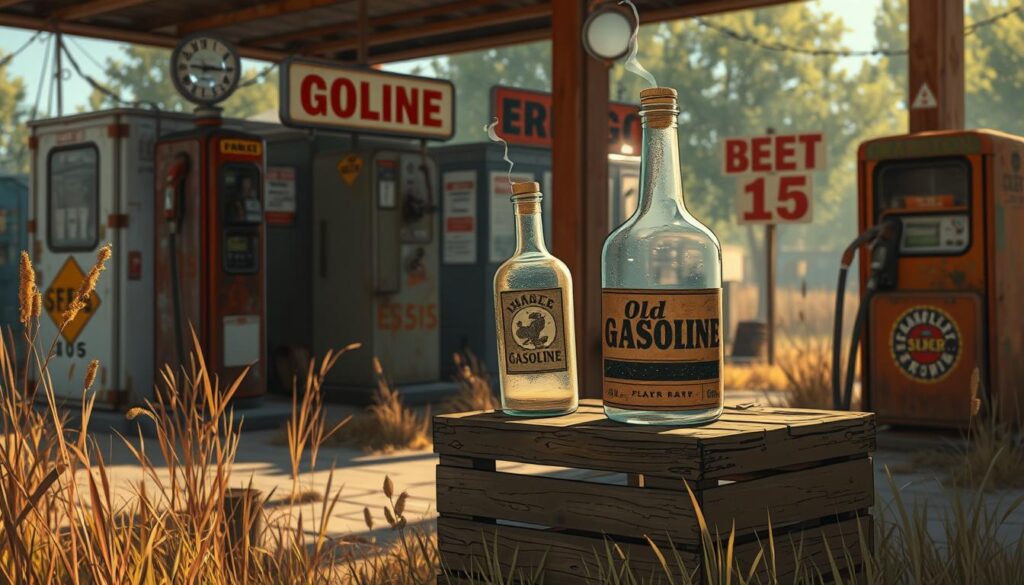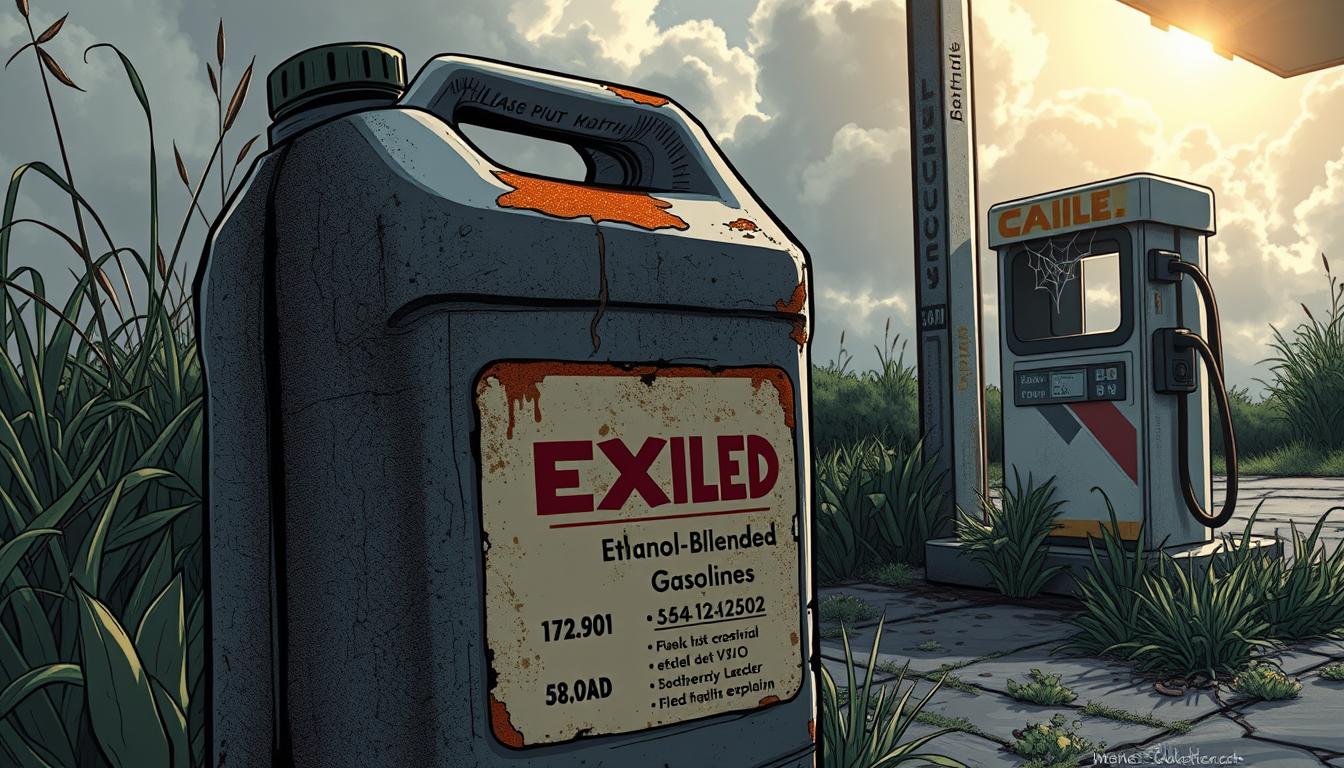Gasoline, whether pure or mixed with ethanol, doesn’t last forever. As someone who loves to drive, I’ve found that pure gasoline can start to break down in 3-6 months. This happens because of oxidation and evaporation.
On the other hand, gasoline blends with ethanol don’t last as long, only 2-3 months. Things like heat, oxygen, and moisture can really affect how well the fuel stays good.
To keep my gasoline fresh, I store it in airtight containers in cool places. This helps a lot.
Contents
Key Takeaways
- Pure gasoline has a shelf life of 3-6 months before it starts to degrade.
- Ethanol-blended fuels have a shorter shelf life of 2-3 months.
- Proper storage in airtight containers and cool environments can help extend the shelf life of gasoline.
- Fuel stabilizers are an effective way to maintain the potency of stored gasoline.
- Storing more than five gallons of fuel in a container is not recommended due to increased volatility and fire/explosion risk.
Understanding Gasoline Expiration
Gasoline, whether it’s pure or mixed with ethanol, starts to break down over time. This happens mainly because of oxidation and evaporation. Oxidation makes the fuel lose its volatile parts and ability to burn. Evaporation causes the lighter parts of the fuel to evaporate, leaving behind a less volatile mix.
The Impact of Oxidation and Evaporation
Oxidation of gasoline creates gum-like deposits and varnish. These can block fuel systems and engine parts. Evaporation lowers the fuel’s quality and performance, making it less efficient for your car.
Factors Affecting Fuel Shelf Life
- Heat and humidity: High temperatures and moisture can speed up oxidation and evaporation, shortening fuel storage life.
- Exposure to air: Gasoline in containers with loose seals or often opened and closed is more likely to degrade.
- Ethanol content: Fuels with ethanol are more likely to get water contamination. This can make the fuel worse and reduce its effectiveness.
Knowing what affects gasoline shelf life is key to keeping your car running well. It helps avoid problems with old fuel.
“Gasoline can expire in as little as four weeks when left dormant in a vehicle’s tank, while fuel stored in jerry cans can last from three to six months in proper conditions.”
The Shelf Life of Different Fuel Types
Pure gasoline can last 3-6 months when kept in sealed containers. Ethanol-gasoline blends, found at gas stations, last about 2-3 months. This difference is due to ethanol’s effect on fuel quality.
Pure Gasoline vs. Ethanol-Gasoline Blends
Ethanol makes fuel degrade faster. It pulls moisture from the air, causing water in the fuel. This can lead to microbial growth and contamination, shortening the fuel’s life.
Role of Fuel Stabilizers
Fuel stabilizers help extend gasoline shelf life. They stop oxidation and evaporation that break down fuel. With these additives, gasoline can last 1-3 years under the right conditions.
| Fuel Type | Shelf Life |
|---|---|
| Pure Gasoline | 3-6 months |
| Ethanol-Gasoline Blends | 2-3 months |
| Gasoline with Fuel Stabilizers | 1-3 years |

Many factors affect fuel shelf life, like storage conditions and temperature changes. Using fuel stabilizers and proper storage can help. This is key for businesses and personal vehicle owners alike.
Does Ethanol-Blended Fuel Have a Shorter Shelf Life?
Ethanol in fuel can affect how long it lasts. E10, a mix of 90% gasoline and 10% ethanol, doesn’t last as long as pure gasoline. Ethanol makes fuel break down faster because it speeds up oxidation and evaporation.
Research says ethanol blends last 2-3 months, while pure gasoline can last 3-6 months if stored right. This is key for boat owners and those using marine engines. They need to manage their fuel well to prevent engine issues and damage.
| Fuel Type | Shelf Life |
|---|---|
| Pure Gasoline | 3-6 months |
| Ethanol-Blended Fuel (E10) | 2-3 months |
To make ethanol-blended fuels last longer, use fuel stabilizers and store them right. Keep the fuel in airtight containers in a cool, dry place. Also, check and replace fuel filters often, and clean the fuel system.
“Ethanol’s solvent properties lead to breakdown of rubber, plastic, fiberglass, aluminum, and steel in the engine.”
Knowing how ethanol-blended fuels differ from pure gasoline is key for keeping marine engines running well. By managing fuel well and using available solutions, users can reduce risks from ethanol-blended fuels’ shorter shelf life.
Dangers of Using Old Gasoline
Using old, degraded gasoline is risky for your car’s engine and fuel system. As gasoline gets older, it loses its ability to burn well. This can make your engine work less efficiently and harm its parts. Also, oxidation can create gum that blocks fuel lines and filters, making engine problems worse.
Potential Engine Damage
Old gasoline might not light up right in the engine. This can cause misfires and less power. It can also lead to:
- Reduced fuel efficiency
- Decreased acceleration
- Increased emissions
- Damage to spark plugs, valves, and other engine parts
Gum Residue and Blockages
Old gasoline can turn into a sticky gum-like substance. This gum can block fuel lines, filters, and other parts in the fuel system. This leads to:
- Difficulty starting the engine
- Engine damage from blocked fuel flow
- Fuel system issues needing cleaning or part replacement
This gum can also cause poor fuel atomization. This makes combustion problems and engine performance worse.

“Utilizing old, degraded gasoline can pose a serious threat to your vehicle’s engine and fuel system.”
Proper Storage of Gasoline
Proper storage is key to keeping your gasoline fresh. By following simple guidelines, your fuel will stay ready for use. Even if it’s been sitting for a while, it will be good to go.
Airtight Containers and Cool Environments
Keeping air and heat away from gasoline is crucial. Use airtight containers like metal or high-quality plastic cans. Make sure they’re labeled with the purchase date. Don’t use glass containers because they can cause fuel to evaporate faster.
It’s also vital to store your gasoline in a cool, dry place. High temperatures and humidity can make the fuel break down faster. This can also increase the risk of fire and explosion, especially with large amounts of gasoline.
BP says petrol can last a year in a sealed container under shelter. After opening, it lasts six months at 20°C or three months at 30°C. Diesel can last 12 months or more if stored properly.
By using airtight containers in a cool, dry spot, you can keep your gasoline in top condition. This ensures it’s ready for use whenever you need it.
Identifying Old Gasoline
Gasoline changes as it ages, showing signs like color and smell changes. These signs tell us the fuel has degraded and is no longer good. Knowing these changes helps prevent problems with your vehicle or equipment.
Changes in Gasoline Color
New, high-quality gasoline looks clear and bright. But, it darkens as it gets older. This happens because the gasoline molecules break down and form darker substances. If your gasoline looks more amber than before, it’s old and not good to use.
Detecting Gasoline Odor Changes
Old gasoline also smells bad, like sour or stale. This smell comes from the fuel breaking down. If your gasoline smells different from when it was new, don’t use it. It could harm your engine and fuel system.
| Fuel Type | Average Shelf Life |
|---|---|
| Pure Gasoline | 6 months or more |
| Ethanol-Blended Gasoline (E10) | 3 months |
| Fuel-Stabilized Gasoline | 1-3 years |
By paying attention to color and smell changes, you can tell when gasoline has gone bad. This helps keep your vehicle or equipment running smoothly.
Extending Fuel Life in Vehicles
For vehicles that sit idle or are stored for a long time, a fuel stabilizer can keep the gasoline fresh. These additives stop oxidation and evaporation that break down fuel. Keeping the fuel system clean with regular maintenance also helps. This includes changing filters and cleaning parts.
Industry experts say fuel with 5% methanol lasts up to 3 months. The ethanol in gasoline should be less than 3% for older cars. At 60°F, E10 fuel can separate with just 0.02 gallons of water, while pure gasoline needs 0.15 teaspoon of water.
Keeping your vehicle’s fuel system in good shape is key. Using fuel stabilizers and regular maintenance can make your gasoline last longer. This way, your car will be ready to go when you need it, even after a long break.
Source Links
- https://ohiocornandwheat.org/corn-checkoff/ethanol/ethanol-myths-debunked/ – Ethanol Myths Debunked | Ohio Corn & Wheat
- https://rislone.com/blog/fuel-system/does-gasoline-go-bad/ – Does Gasoline Go Bad? | Rislone
- https://www.popularmechanics.com/cars/a43168378/gas-has-an-expiration-date/ – Gasoline Has a Surprisingly Short Shelf Life, Which Might Ruin Your Post-Apocalyptic Plans
- https://www.neighbor.com/storage-blog/how-long-can-gas-sit-in-a-car/ – How Long Can Gas Sit in a Car Before it Becomes Unusable? – Neighbor Blog
- https://number1autotransport.com/car-shipping-blog/general-automotive/how-long-does-gasoline-last-in-the-fuel-tank-before-it-expires/ – How Long Does Gasoline Last in the Fuel Tank Before It Expires? | Number 1 Auto Transport
- https://moffittservices.com/stored-fuel-longevity-and-best-practices/ – Stored Fuel Longevity and Best Practices
- https://veloce-vault.com/news/how-long-can-gasoline-sit/ – How Long Can Gasoline Sit In a Car? – Veloce Vault
- https://www.mncorn.org/2022/03/01/setting-the-record-on-using-ethanol-in-small-engines/ – Ethanol in Small Engines – What You Need to Know | MCGA
- https://bluedotmarine.com/ethanol-fuel-information – Blue Dot Marine
- https://www.powerimplements.com/blog/navigating-ethanol-fuel-tips-for-boat-owners–76349 – Navigating Ethanol Fuel: Tips for Boat Owners
- https://b3cfuel.com/resources/frequently-asked-questions/ – Frequently Asked Questions – B3C Fuel Solutions – Fuel Additives & More
- https://wilsonauto.com/old-gas-modern-day-fuel-and-the-issues-they-cause-for-classic-cars/ – Old Gas, Modern-Day Fuel and the Issues They Cause for Classic Cars | Wilson Auto Repair
- https://autoexpert.com.au/posts/shelf-life-of-fuel – Shelf Life of Fuel: How long is too long for petrol and diesel? — Auto Expert John Cadogan
- https://www.bellperformance.com/blog/fuel-storage-recommendations-for-everyone – Fuel storage recommendations for everyone
- https://www.bobvila.com/articles/how-long-does-gasoline-last/ – How Long Does Gasoline Last?
- https://www.hsoil.com/gas-myth-does-gas-expire/ – Gas Myth: Does Gas Expire? – Home Service Oil Company
- https://www.bellperformance.com/blog/how-to-protect-your-classic-car-from-modern-ethanol-fuel-problems – How to Protect Your Classic Car from Modern Ethanol Fuel Problems
- https://www.thevog.net/threads/fuel-shelf-life-fact-or-fiction.54340/ – fuel shelf life,,, fact or fiction ?
- https://www.bellperformance.com/blog/how-to-store-fuel-to-make-sure-its-there-when-you-need-it – How to store fuel (to make sure it’s ready when you need it)

Hi, I’m Sufiyan, the developer behind this platform. I created FuelConsumptionCalculator.com to simplify fuel tracking for everyone — because understanding your vehicle shouldn’t require a degree in mechanics. I’m always working on adding more tools and content to make this site even more useful

